Septic “Uponor”: device, advantages and disadvantages, review of the model range
A well-known Finnish manufacturer of sanitary equipment produces high-quality cleaning systems. The model range is represented by both filtration systems and biological action stations.
Each of them is made of high quality materials, taking into account the climate of sulfur countries. A wide range of products allows you to choose a septic tank "Uponor", which meets the needs of the buyer.
In this material, we will talk about the device and the principles of operation of Uponor septic tanks and conduct a brief overview of models with various types of wastewater treatment.
The content of the article:
The device of septic systems “Uponor”
The functionality directly depends on which model line the septic system belongs to. A common design feature of Uponor septic tanks is the use of high-quality high-strength and frost-resistant plastic.
Another feature is the anchor system. It is a plastic weighting materials, pairwise fastened with cables.
Fixation is achieved due to the mass of soil, which prevents the plates from moving. They are thrown over containers and fix them. This is necessary to prevent septic tank displacement when raising groundwater. This displacement inevitably leads to deformation of the pipes and nozzles of the drainage system.
Complete set of model line “Uponor Sako”
The advantage of these models is the lack of demand for electricity. Septic tanks with Uponor Sako filtration system have a certain basic configuration.
This is one or more plastic tanks connected by overflow pipes. Capacities are solid. The overflow pipes are removable, which makes it easy to replace them in case of mechanical or other damage if necessary.
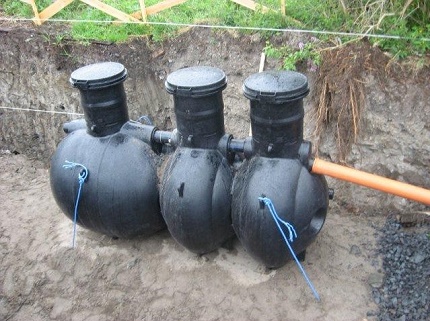
Additionally, a distribution well is included. Its function is to uniformly distribute the flow of filtered water through the aeration pipes. With it, you can reduce the volume of water passage on a landscape with an increased slope.
The filtration field consists of perforated pipes that are installed in a poured cushion of gravel and sand. Passing through the drainage, the wastewater goes into the ground, where they are subsequently treated. The number of aeration perforated pipes (1-6) directly depends on the performance and volume of the septic tank.
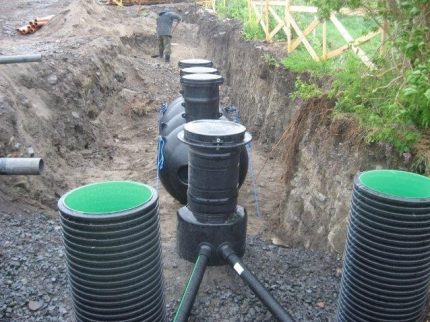
It performs the function of evenly distributing the purified liquid over several aeration pipes. At the same time, it is also an inspection well for cleaning quality control. It has a flow regulator that allows you to control the pressure of the effluent.
Corrugated pipes are laid from the septic tank to the distribution well. They also serve as the connection between the distribution well and perforated pipes. Also included are plugs, top manhole covers and filter cloth.
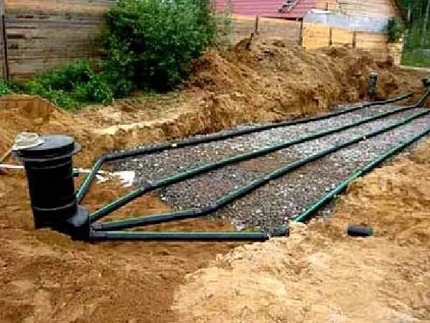
The cleaning process in Uponor Sako septic tanks is similar to overflow wells. However, there is a difference in the structure and operation of the system. In it, sewage treatment takes place in two stages.
At the first stage, all large fractions of wastewater settle at the bottom of three sedimentation tanks. In the second stage, the water that has passed through all the tanks is subjected to additional purification through filtration fields.
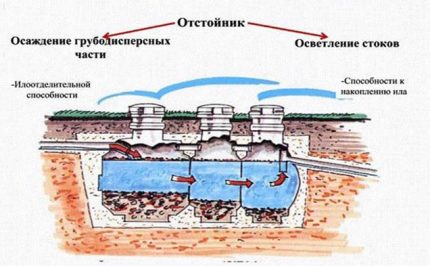
The step-by-step process for cleaning sewage is as follows:
- After draining the waste mass into the sewer, it moves through the pipes into the first communicating tank. Here, large fractions settle to the bottom.
- The liquid freed from insoluble inclusions settled to the bottom, but with the presence of a fine suspension, flows into the second communicating reservoir. Here the process of settling water is repeated.
- If the modification provides for the presence of three tanks, then in the third, water also settles.
- Then, purified water with a small amount of impurities goes into a distribution well, from where it evenly flows into perforated pipes.
- From the holes, water enters the sprinkled cushion, where they are further treated by natural filtration in the soil.
If you install an additional filter module - an infiltrator, which is an underground system for discharging treated effluents into a ditch, additional treatment is carried out in it.
Infiltrator like filtration field or an absorption well can only be used if, between the conditional bottom of the systems, the highest groundwater level in the area is at least 1 m.
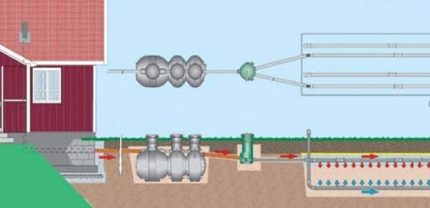
Complete set of the Uponor Bio lineup
Uponor Bio systems have excellent cleaning quality. Their use is permitted in conservation areas. They are compact and require less floor space. It works autonomously, but for this it needs electricity.
The complete set for all Uponor Bio septic tanks is also identical for the entire model line. An anchor system is also not included in the basic package.
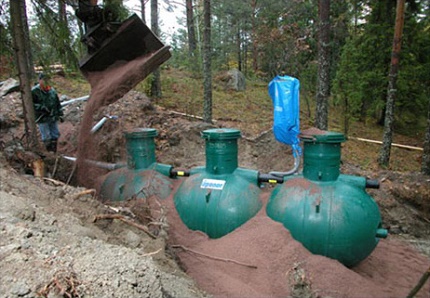
The package includes a cast tank, divided into three compartments or three interconnected containers. The system of internal pipes and pumps is located in tanks and does not need to be mounted. It is enough to connect the pipes for the passage of drains. Additionally, the kit includes equipment that consists of pumps and control modules.
Thanks to electronics, the system is able to independently exist and maintain the activity of microorganisms in the event of a downtime of not more than three months. All system control is carried out remotely. In addition, 15 liter tanks are included in the kit, where reagents and special bacterial compounds are poured.
The tanks are equipped with a system for feeding small portions of contents to the tanks of the settlers. Additionally, you can order a well for wastewater sampling for their biochemical research.
The effluents flowing along the sewer line into the receiving tank of the septic tank undergo triple treatment. For clarity, each stage is represented by illustrations.

There, the process of settling sewage is repeated. After repeated precipitation, the upper layer of purified water is transferred to the process tank.
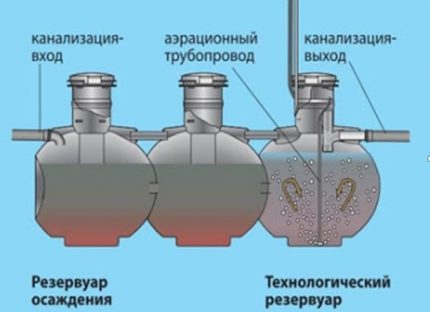
Then the system waits for the necessary time for the deposition of sludge at the bottom of the process tank.After a few hours, sludge precipitation occurs and the third stage of wastewater treatment takes place. It uses chemicals.
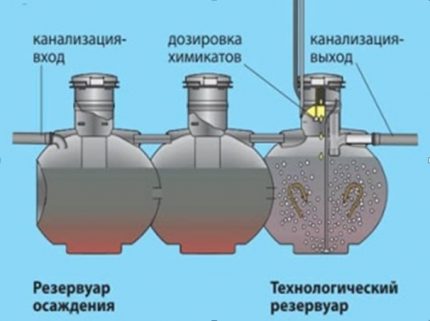
Then, sludge is pumped out from the bottom of the tank.
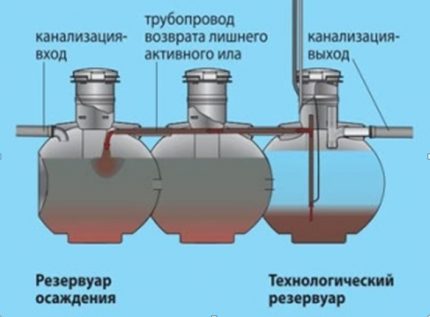
Purified water is removed when filling the tank, through a pipe in the upper part of the tank. After that, it is transported through a pipeline into a drainage ditch.
Additionally, a preparation containing anaerobic bacteriasince the amount of air in biological treatment systems is minimized. This will further increase the degree of wastewater treatment, and eliminates fat deposits on the walls of the tank.
Overview of septic system models
For the correct choice of a septic system, it is necessary to be guided by several basic rules. If the status of the territory on which the site is located falls under environmental legislation, it is necessary to choose systems with a biological type of treatment.
If the site does not have the status of a conservation zone, the septic system must be selected based on the area. If it allows you to set a filter field, you can select a filter system.
Another factor to consider is the groundwater level on the site. If it is high, biological treatment systems must be preferred. Having decided on the type of system, you can proceed to the choice of model. It must be selected by the number of people living. Better to take with a margin.
Filtration type cleaning
The Sako model line is represented by the following modifications:
- Uponor Sako 1.5 m3
- Uponor Sako 2.0 m3
- Uponor Sako 3.0 m3
- Uponor Sako 4.0 m3
Each model is designed for a different number of people living and the intensity of the load.
Uponor Sako 1.5 m3
It has small dimensions. It is designed for three permanent residents. Its productivity is small and accounts for half of the capacity of the tank per day.
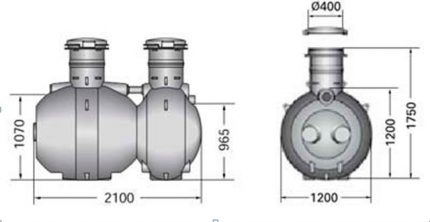
The septic tank needs additional warming. The system requires a smaller filtration field (two branches of perforated pipes), which saves space on the site.
Since the volume of wastewater is small, you can do without a system for discharging treated effluents from the aeration field. The manufacturer has a warranty period of five years.
Uponor Sako 2.0 m3
This modification is designed for installation in a house where 4 or 5 people are planned to stay. The system perfectly copes with different types of domestic wastewater.
Unlike the previous model, he needs to install a distribution well, due to the large volume of effluents.
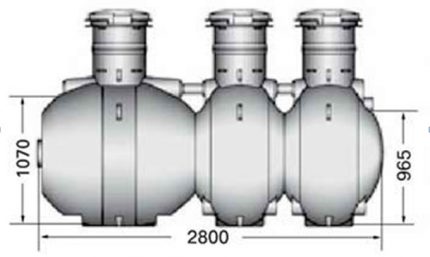
To reduce the area of the filtration field, you can use infiltration modules. Due to them, the field area is reduced by half. The system can use biologically active drugs that increase the cleaning efficiency. From the septic tank practically no unpleasant smell of waste products comes from.Warranty period is 5 years.
Uponor Sako 3.0 m3
This model perfectly copes with a large volume of wastewater. Productivity per day is half the capacity.
The septic system is designed for installation in a house where 6 or 7 people are planned to stay. Effectively processes all types of domestic wastewater.

For the model, it is mandatory to use a distribution well, which will help to evenly drain drains through aeration pipes.
The filtration field without the use of an infiltration system will have significant dimensions. To reduce the cost of the installation process and reduce labor costs, it is recommended to use an infiltration system. The warranty period is 5 years.
Uponor Sako version 4.0 m3
This modification is designed for installation in a house where up to 10 people are planned. It is possible to use one container for two closely located households.
The system perfectly copes with different types of domestic wastewater. Needs installation of a distribution well. Even when using an infiltration system, it is necessary to lay three branches of aeration pipes.
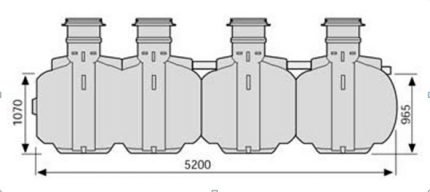
Does not need additional insulation. An exception can be made for the area where the freezing of the soil exceeds 1.5 m. Recommended by the manufacturer, the frequency of pumping out sludge is once every two years.
An unpleasant odor of wastewater is not observed, with proper installation of ventilation pipes. The warranty period is five years.
Biochemical type of purification
The Bio model line is represented by the following modifications:
- Bio Clean 5.
- Bio 10.
- Bio 15.
The number in the model name indicates the maximum number of people who can use the treatment station during the year. Biological treatment system has a higher efficiency. The percentage of cleaning is about 98%.
Uponor Bio Clean 5
The system consists of two interconnected tanks, which are located in one housing. In the first tank, heavy fractions of domestic wastewater are deposited.
In the second, technological processing by aeration takes place, followed by cleaning with special chemical compounds.
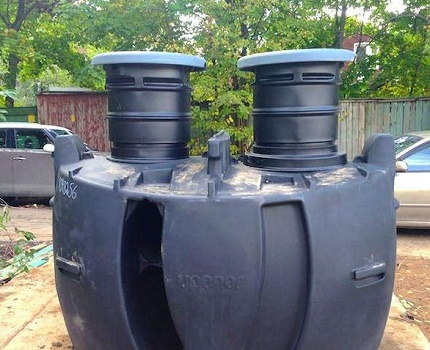
During the day, the station processes 1,000 cubic meters. liters. The model consumes 45 liters of chemicals per year for maintenance. The system is equipped with sensors that inform about the excess volume of a one-time drain. This is true for those who periodically forget to close the tap. The warranty on capacity is 5 years, and the warranty period for the control module is 2 years.
Uponor Bio 10
The system consists of five interconnected tanks, which are located one after another. The first tank has a significant volume, which allows processing up to 1,500 cubic meters. liters per day. In the first tank, heavy fractions of domestic wastewater are deposited.
The second to fourth capacities perform the same functions. In the fourth, technological processing by aeration takes place, followed by cleaning with special chemical compounds.
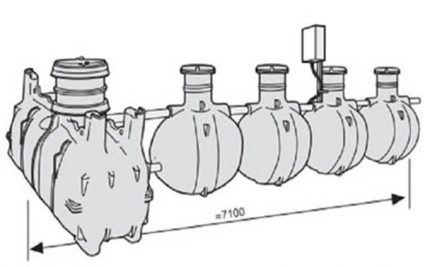
The model consumes 90 liters of chemicals per year for maintenance. The system is equipped with sensors that inform about the excess volume of a one-time drain.
The system has impressive dimensions and lifting equipment is required for its installation. The warranty on capacity is 5 years, and the warranty period for the control module is 2 years.
Uponor Bio 15
The system consists of seven communicating tanks. The first and second tanks have a significant volume, which allows you to process up to 2,200 cubic meters. liters per day. In the first tank, heavy fractions of domestic wastewater are deposited.
The second to fourth capacities perform the same functions. The fifth is technological processing by aeration, followed by cleaning with special chemical compounds.
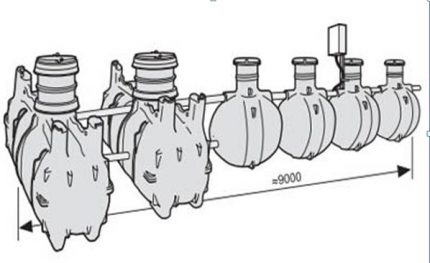
The model consumes 120 liters of chemicals per year for maintenance. The system is equipped with sensors that inform about the excess volume of a one-time drain.
It has impressive dimensions, which is why lifting equipment is necessary for its installation. The warranty on capacity is 5 years, and the warranty period for the control module is 2 years.
Care and maintenance
In order to ensure proper functioning and extend the life of the product, it is necessary to clean the deposition tanks of septic systems in a timely manner. This also applies to biological treatment plants. If you do not pump sludge from the bottom of the tank, over time it becomes more viscous and compacts.
In this case, a hard crust may form on the surface. Special biological preparations help to deal with these problems, which may occur during untimely pumping.
The Uponor Saco septic tank models require special preparations that clean the holes of the spray pipes from clogging. For this, it is necessary to use biochemical preparations. They extend the life of the filtration field.
Models of Uponor Bio septic tanks require the use of chemicals. You can use third-party tools. The main criterion should be the ability to break down and process phosphates. This is the end of the Uponor septic system care process.
Advantages and disadvantages of Uponor systems
At first glance, the Sako range does not differ from the more affordable Russian-made counterparts, but this is not so. It is impossible to find a septic system of such a form as that of Uponor.
The spherical shape allows you to make the tank more resistant to water and soil pressure. In combination with high-quality plastic, an increase in the life of the product is achieved. The disadvantages include the high cost of the product. In addition, some models must be insulated.
The range of septic tanks “Uponor” of the “Bio” series has its drawbacks and advantages. The advantages include quality cleaning. Not every system has a purification percentage of 98%.
The indisputable advantage of the system is the control and sensors that transmit signals about the state of the system. The disadvantage is the need for electricity. The installation can be powered from home by removing the cable, or install a solar panel with a battery.
Another disadvantage is the cost of maintaining the Bio systems. They need special chemicals to enhance wastewater treatment.
The device model itself eliminates the need to dig out the tank, since all the technical mechanisms are located so that they can be easily replaced if necessary. In addition, the warranty period for the control module can be attributed to the disadvantages. It is only two years old.
We also recommend that you read an article about what criteria you need to pay attention to when choosing a septic tank for a home. Read more - read Further.
Conclusions and useful video on the topic
This model of the “Bio” family has a compact size and can be mounted without the use of special loading equipment:
The service life of the septic tanks of biological treatment plants of the Uponor company is many times higher than declared in the guarantee. The cost of septic systems is higher than similar offers on the Russian market, but in the long run it allows saving.
The design of the septic tanks is arranged in such a way that the number of possible breakdowns is minimized. The models exclude deformation of the case, as they have a spherical or cylindrical appearance.
Have you been using the Uponor septic tank for a long time and can you give practical advice to those who are just going to purchase it? Or you still can not choose among the modifications of biological treatment plants? Please leave your comments, ask questions, share your experience in the block under the article.

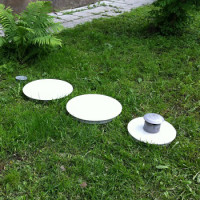 Septics DKS (KLEN): device, a review of the model range, advantages and disadvantages
Septics DKS (KLEN): device, a review of the model range, advantages and disadvantages 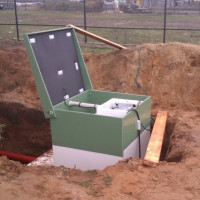 Overview septic tank for giving “Topas”: principle of operation, device, advantages and disadvantages
Overview septic tank for giving “Topas”: principle of operation, device, advantages and disadvantages 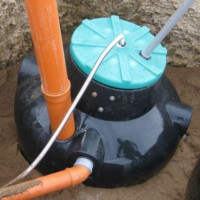 Septic “Fast”: a review of the lineup, reviews, installation and operation rules
Septic “Fast”: a review of the lineup, reviews, installation and operation rules 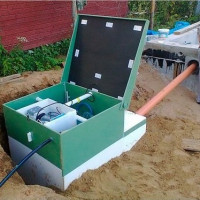 Overview of the septic tank “Eurobion Yubas”: device, advantages and disadvantages, comparison with competitors
Overview of the septic tank “Eurobion Yubas”: device, advantages and disadvantages, comparison with competitors 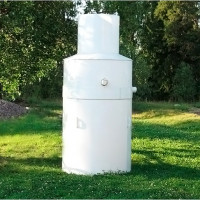 Overview of the cedar septic tank: device, principle of operation, advantages and disadvantages
Overview of the cedar septic tank: device, principle of operation, advantages and disadvantages  Review of septic tanks “Mole”: device, advantages and disadvantages, comparison with competitors
Review of septic tanks “Mole”: device, advantages and disadvantages, comparison with competitors  How much does it cost to connect gas to a private house: the price of organizing gas supply
How much does it cost to connect gas to a private house: the price of organizing gas supply  The best washing machines with dryer: model rating and customer tips
The best washing machines with dryer: model rating and customer tips  What is the color temperature of light and the nuances of choosing the temperature of the lamps to suit your needs
What is the color temperature of light and the nuances of choosing the temperature of the lamps to suit your needs  Replacement of a geyser in an apartment: replacement paperwork + basic norms and requirements
Replacement of a geyser in an apartment: replacement paperwork + basic norms and requirements
I want to order the Uponor Bio septic tank, but it seems like for its autonomous work a constant supply of electricity is needed. Are there any ways to provide the system with electricity in remote areas other than a generator?
Good afternoon, Matvey. Absolutely all deep-septic tanks require power supply, at least for a compressor.
Instead of a generator, you can use solar panels. If you correctly calculate and install the required number of batteries, then their charge is quite enough for the compressor to operate autonomously at night. I recommend that you familiarize yourself with our article about solar panels.
For how long are such septic tanks designed? How long will it work without breakdowns? How is winter tolerated, -40 will it survive?
Hello. The operating temperature of the septic tank is 35 degrees. But since the freezing temperature of the chemical reagent is 30 degrees, to increase the temperature range of operation, the installation is advised to insulate 10 cm with polystyrene foam. The behavior of Uponor designed for lower temperatures in the -40 mode is not known.
As for breakdowns. As a rule, a manufacturer’s warranty of 5 years is installed on the septic tank, and 2 years on the control unit. If someone has been using it for several years, we ask you to share your experience in the comments ... However, the manufacturer assures that the period of actual operation of these septic tanks exceeds the warranty.